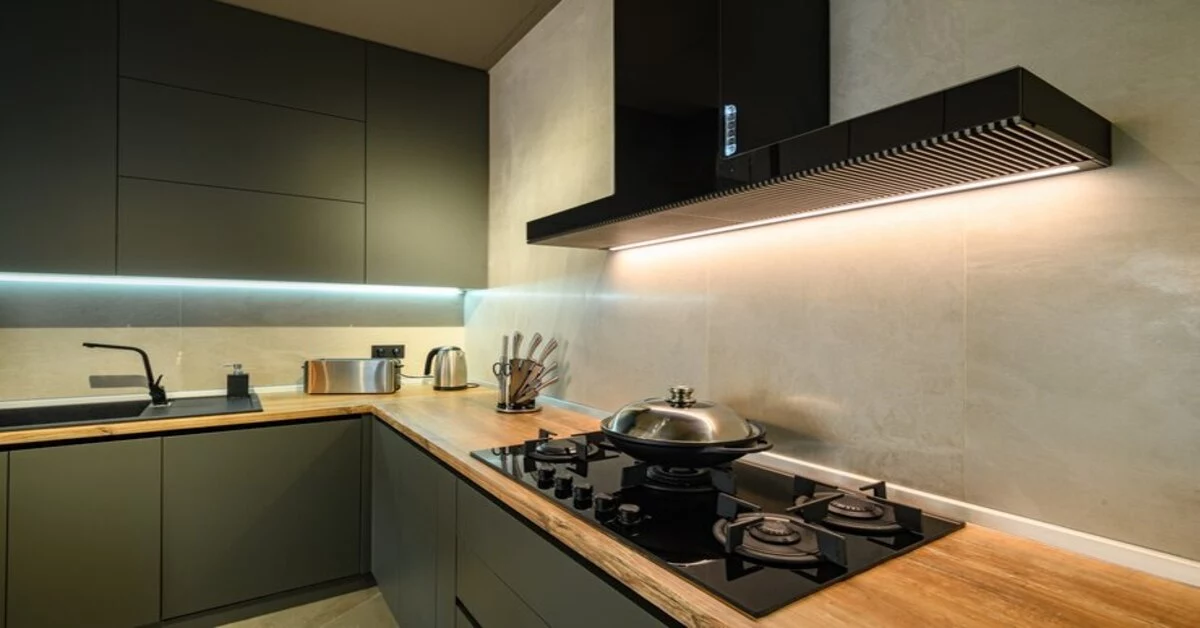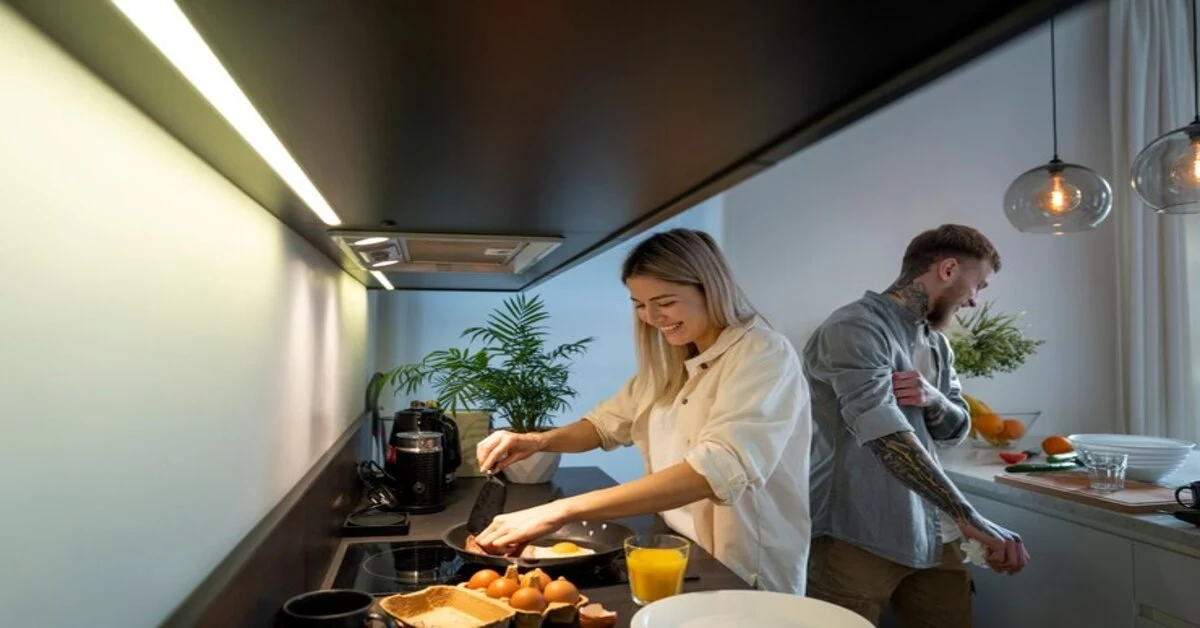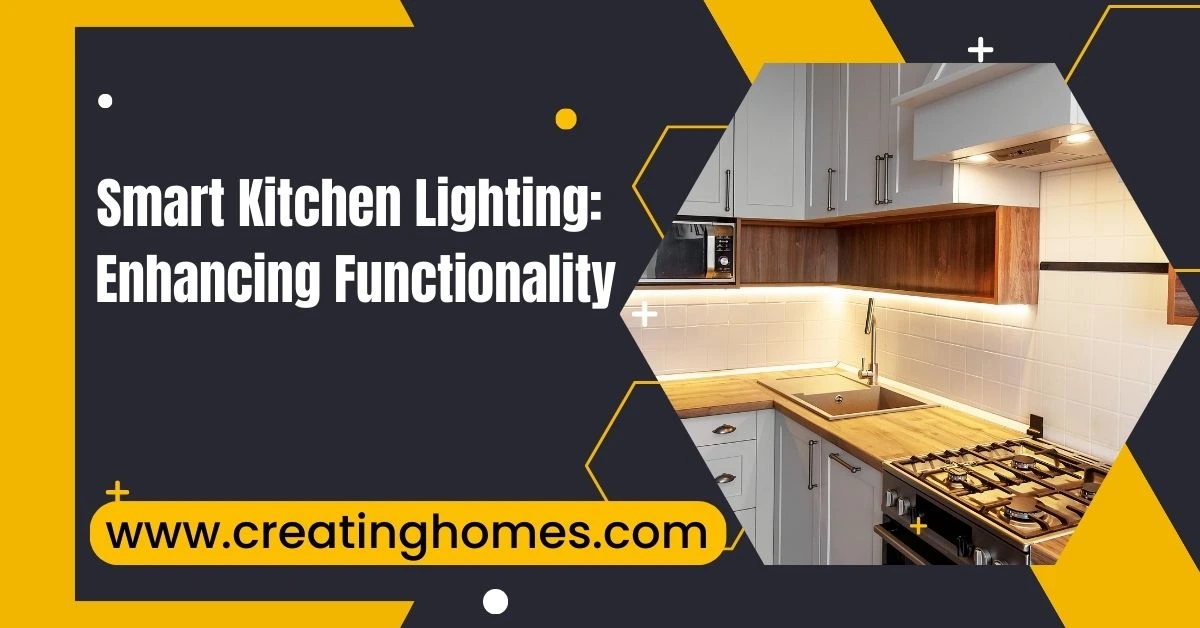Lighting in a kitchen serves a dual purpose beyond mere illumination. It sets the ambience for culinary activities while aiding in safety and functionality. However, the evolution of smart technology has elevated the role of lighting beyond the conventional, introducing a new era in home design and functionality.
Importance of Lighting in a Kitchen
Affordable construction companies in Dubai understand the kitchen’s pivotal role. Lighting isn’t just about brightness; it’s creating an atmosphere conducive to tasks, from chopping veggies to hosting dinner parties where families gather and culinary masterpieces come to life.
Rise of Smart Lighting
In recent years, the emergence of smart home technology has revolutionized the way we interact with our living spaces. Smart lighting, in particular, has gained momentum, offering homeowners unprecedented control and customization options. From adjusting brightness to changing hues, the possibilities are endless, all at the tap of a screen or the sound of your voice.
Thesis Statement
This exploration delves into the transformative impact of smart lighting within kitchen spaces. We’ll uncover the manifold ways in which smart lighting enhances functionality, convenience, and ambience, redefining the kitchen experience for the modern homeowner.
 Understanding Smart Kitchen Lighting
Understanding Smart Kitchen Lighting
In the realm of modern home innovations, smart lighting systems have emerged as game-changers, particularly within kitchen spaces. Let’s delve into the intricacies of these systems and the manifold benefits they offer:
Exploring Smart Lighting Components
Smart lighting encompasses an array of components designed to revolutionize how we illuminate our homes. It comprises:
- Smart Bulbs: These LED bulbs are the core elements, integrating wireless capabilities to connect and communicate with various devices for control.
- Smart Switches: They serve as interfaces between traditional electrical systems and smart bulbs, enabling manual control or remote access.
- Sensors: Motion sensors, ambient light sensors, and occupancy sensors are integral components that detect movement, measure light levels, and adjust illumination accordingly.
Advantages Of Traditional Lighting
The shift to smart lighting isn’t merely about novelty; it’s about enhancing efficiency, customization, and overall convenience:
- Energy Efficiency: Smart bulbs are designed to be more energy-efficient than traditional incandescent bulbs, leading to reduced electricity consumption and lower bills.
- Customization: With the ability to adjust brightness levels and colour temperatures, users can create tailored lighting setups to suit various tasks and moods.
- Convenience: Control at your fingertips! Smart lighting systems can be managed remotely via smartphone apps or integrated with voice assistants, offering unparalleled convenience and flexibility.
Types of Smart Lighting Ideal for Kitchen Spaces
A well-lit kitchen demands a thoughtful combination of lighting types to cater to diverse activities:
- Under Cabinet Lighting: These fixtures illuminate countertop workspaces, enhancing visibility for food preparation and cooking tasks.
- Overhead Lighting: Essential for overall ambient lighting, overhead fixtures provide general illumination for the entire kitchen area.
- Task Lighting: Specifically targeted at workstations, task lighting fixtures focus light on areas where detailed activities like chopping, reading recipes, or cooking occur.
Smart versions of these lighting types optimize functionality, offering adjustable brightness levels and tailored settings for different kitchen needs.
Functional Features of Smart Kitchen Lighting
Smart kitchen lighting isn’t just about illumination; it’s a sophisticated system designed to cater to specific needs and tasks within the culinary hub. Let’s explore the functional facets that make it a transformative addition to any kitchen:
Customization and Control
- Adjusting Brightness and Color: Smart lighting systems empower users to fine-tune the brightness levels and colour temperatures to create the perfect ambience. Whether it’s a vibrant, energizing atmosphere for morning cooking or a warm, cosy setting for evening meals, these adjustments are easily attainable.
- Integration with Voice Assistants or Apps: The integration of smart lighting with voice assistants like Alexa or Google Home, as well as dedicated smartphone apps, allows for seamless remote control. Simply voice your commands or tap on your device to transform the kitchen’s lighting dynamics.
Enhanced Task Lighting
- Significance of Task Lighting: In cooking areas, adequate task lighting is indispensable. It ensures precise visibility for activities like chopping, reading recipes and working with ingredients. Smart lighting can be strategically employed to illuminate these specific zones, reducing eyestrain and enhancing efficiency.
- Tailoring for Specific Tasks: Whether it’s brightening the countertop for meal prep, adjusting lighting intensity over the stove for cooking, or creating a cosy ambience for dining, smart lighting systems offer tailored settings for each culinary task.
Adaptive Lighting
- Motion Sensors and Adaptive Lighting: Motion sensors play a pivotal role in adaptive lighting. These sensors detect movement and adjust the lighting accordingly, ensuring that the kitchen is well-lit when occupied and conserving energy when not in use.
- Benefits of Adaptive Lighting: This hands-free operation not only enhances convenience but also contributes to energy savings by eliminating the need to manually switch lights on or off, making it an eco-friendly choice for your home.
Practical Applications and User Experience
The true essence of smart kitchen lighting lies in its ability to transform the kitchen into a versatile and adaptable space. Let’s explore how users can leverage these systems to enhance ambience and seamlessly integrate them into their smart home ecosystem:
Ambiance Setting
Mood Creation with Lighting: Smart lighting isn’t just about brightness; it’s about setting the mood. Imagine adjusting the kitchen’s ambience to suit various occasions:
- Entertaining Guests: Create an inviting atmosphere with warm, dimmed lights perfect for hosting gatherings or dinner parties.
- Family Dinners: Opt for brighter, well-distributed lighting that fosters a lively yet comfortable setting for family meals and conversations.
- Late-Night Snacks: Dim the lights to a soft glow for a relaxed and cosy vibe during late-night kitchen visits.
- Examples of Scenarios: Illustrate these scenarios with real-life examples or fictional scenarios to showcase the versatility and adaptability of smart kitchen lighting in different situations.
Integration with Smart Home Ecosystem
Smart Kitchen Lighting as Part of a Larger System: The beauty of smart home technology lies in its interconnectedness. Smart kitchen lighting seamlessly integrates into a broader ecosystem of smart devices.
Potential Integrations: Showcase how smart kitchen lighting can complement and synchronize with other smart devices:
- Voice-Controlled Devices: Integration with voice assistants allows users to manage lights alongside other smart appliances or functions, enhancing overall convenience.
- Synchronization with Security Systems: Linking lighting with home security systems can simulate occupancy when homeowners are away, enhancing home security measures.
Practical Applications and User Experience
Smart kitchen lighting transcends mere functionality; it elevates the kitchen experience by offering versatility and integration within the broader smart home ecosystem. Let’s explore how these aspects enhance user experience:
Ambiance Setting
- Creating Varied Moods and Settings: Smart lighting’s versatility shines in its ability to set diverse moods within the kitchen space. From vibrant and lively settings ideal for entertaining guests to warm and cosy atmospheres perfect for intimate family dinners, the possibilities are vast.
- Scenario Examples: Consider scenarios where different lighting settings could be applied. For instance, bright, well-lit settings for meal prep, dimmed lights for a relaxed dinner ambience, or subtle lighting for late-night snacks without disturbing the household.
Integration with Smart Home Ecosystem
- Part of a Larger Smart Home Setup: Smart kitchen lighting seamlessly integrates into a broader smart home ecosystem. This interconnectedness allows users to control various aspects of their home, including lighting, security, temperature, and entertainment systems, all from a centralized hub.
- Potential Integrations with Other Smart Devices: Imagine the convenience of syncing your smart lighting with devices like smart thermostats or home security systems. For instance, lighting adjustments are made when the security system detects movement, enhancing both safety and energy efficiency.
Choosing the Right Smart Lighting System
Selecting the ideal smart lighting system for your kitchen involves a thoughtful evaluation of various factors. Let’s explore the considerations, available options, and tips for seamless installation and setup:
Factors to Consider
- Budget Considerations: Determine a budget that aligns with your requirements and explore options within that range. Remember, while initial costs may vary, energy-efficient smart lighting systems often result in long-term savings.
- Compatibility and Integration: Ensure compatibility with existing smart home devices or the potential for future integration. Opt for systems that offer versatility and compatibility with various platforms.
- Ease of Installation and Use: Evaluate the ease of installation; some systems may require professional setup while others offer straightforward DIY installation. User-friendly interfaces and intuitive controls also enhance user experience.
Comparison of Popular Smart Lighting Brands
- Brand Comparison: Explore the offerings of popular smart lighting brands like Philips Hue, Lutron Caseta, and Nanoleaf. Compare their features, compatibility, and user reviews to identify the best fit for your kitchen.
Tips for Installation and Setup
- Placement Strategy: Strategically position lighting fixtures to ensure optimal coverage and functionality. Task lighting should be focused on work areas, while ambient lighting should provide overall illumination.
- Follow Manufacturer Guidelines: Adhere to the manufacturer’s instructions during installation and setup. Proper installation ensures optimal performance and longevity of the smart lighting system.
- Utilize Smart Features: Familiarize yourself with the features and capabilities of your chosen system. Experiment with different settings and controls to maximize functionality and tailor the lighting to your preferences.
 Conclusion
Conclusion
In the evolution of home design, smart kitchen lighting has redefined functionality. Its adaptability, allowing control over brightness, colour, and ambience, revolutionizes tasks from food prep to dining. Integration within the smart home ecosystem enhances experiences, syncing settings effortlessly.
Choosing the right system, considering budget, compatibility, and ease of installation, ensures a tailored fit. This innovation signifies a bright future, promising even more intuitive interfaces and energy-saving capabilities. Smart kitchen lighting transcends mere illumination, shaping modern living. From setting the mood for family dinners to optimizing task lighting, it epitomizes technology’s fusion with everyday life. This journey into the world of smart kitchen lighting illuminates its transformative impact, ushering in a new era of home lighting.







